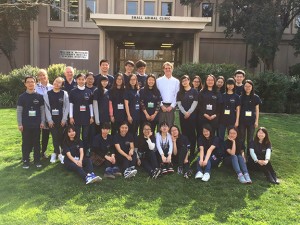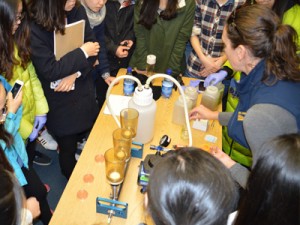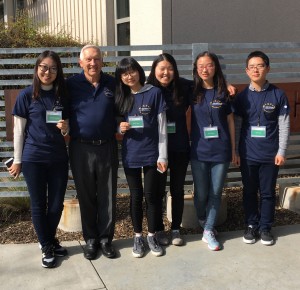Team Work Helps Solve Food Safety Problems
Chris Brunner, February 23, 2016

Rob Atwill, Director, Western Institute for Food Safety and Security, stands with conference participants, (center).
The potential risk to human health from excessive pesticide residues in the environment entering the human food chain was one of the food safety problems which students chose to address during the 3-week NAU-UC Davis Graduate Education Conference on One Health.
Twenty-seven students from Nanjing Agricultural University, majoring in studies as diverse as plant protection, horticulture, veterinary medicine, agricultural resources and environment, ecology, food quality and safety, grassland science, and animal sciences, recognized a solution to the problem begins with team work. Organizing into five teams, they quickly put into practice the kind of multi-disciplinary cooperation it takes to address food safety issues.
The conference, sponsored by Nanjing Agricultural University, (NAU), and hosted by the Western Institute for Food Safety and Security, (WIFSS), was held on the UC Davis campus, January 25 through February 12. Education was a focal point benefitting the students using blended learning which incorporated multidisciplinary information to develop plans for addressing these complex environmental, animal and human problems facing agriculture and society. Thirty one faculty and staff from agriculture, biology, veterinary medicine and medicine all participated by informing students of their respective specialties. Students then selected from the broad base of information to assemble creative ways to address the societal and agricultural issues.

Melissa Partyka a staff research associate with the Atwill Water and Foodborne Zoonotic Disease Laboratory demonstrates water sample processing using membrane filtration for bacterial analysis.
Through lectures, field and laboratory experiences, and group discussions, conference participants learned the essence of what is required to assimilate a team to gather the information for a hypothesis, plan the approach, collect the appropriate samples, evaluate the data to determine the cause, and then recommend solutions to the problem. This holistic approach involves the basis of the One Health concept required for solving these complex problems.
During a field trip to California’s Salinas and Central Valley, the students learned first-hand about the unique ecosystems of the state’s plant and animal agriculture where vast produce fields are adjacent to livestock and wildlife.
The School of Veterinary Medicine, (SVM), College of Agricultural and Environmental Sciences, (CAES), and the Western Institute for Food Safety and Security, (WIFSS), have formed an educational exchange program with Nanjing Agricultural University (NAU) directed at establishing a joint partnership for a One Health Center for Food Safety at NAU. Research at the Center will focus on understanding food safety and water quality issues across Asia. Corresponding educational programs will promote progress toward safer, better quality food systems in China. The vision of the joint One Health Center for Food Safety at NAU is to house a multidisciplinary faculty working on a wide array of projects related to food and water safety using a One Health approach. The primary focus of the One Health Center for Food Safety is to build capacity for education and research expertise at NAU relative to One Health for Asia and globally.

Members of the Green Team pose with their team leader, Bennie Osburn, Director for Outreach and Training at WIFSS.
On the last day of the conference each team described their chosen food safety problem, the short and long term solutions to the problem, and their vision of what it looks like when the problem is solved. Understanding that One Health encompasses, people, animals, and the environment, the teams highlighted that we can all make a difference in providing a sustainable food supply, and a safe and healthy environment for animals and people throughout the world.
